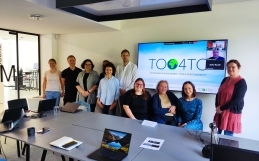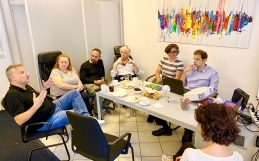Starbucks is well-known around the world for its roasted coffee, but it’s also a bright example of a successful, effective digital transformation.
Starbucks intensively started to accumulate and analyze huge amounts of data. They are now incorporating data analytics into their marketing and sales efforts. The company has tons of data about their clients. It can see what kind of coffee their customers are ordering and adjust their offerings accordingly. They can personalize offers and marketing materials. Finally, they can help to increase sales and cut costs of ineffective ads and marketing.
The most important part of the process of “Starbucks being an experience” is a mobile application and the Starbucks Rewards program. Their app allows quick and easy payments. The loyalty program rewards users and offers some additional features like a store locator and music recommendations. Their “Digital Flywheel” is focused on four pillars: rewards, personalization, payment, and order. It’s a good example of a customer-first strategy. The app, together with a large loyalty program, addresses the basic customer needs: convenience and line avoidance.
Starbucks has been using reinforcement learning technology — a type of machine learning in which a system learns to make decisions in complex, unpredictable environments based upon external feedback — to provide a more personalized experience for customers who use the Starbucks mobile app. “Just like their relationship with a barista, customers receive the same care and personalized recommendations when it comes from our digital platforms,” says Jon Francis, senior vice president, Starbucks Analytics and Market Research.
Another contributor to Starbucks’ success is the IoT-enabled machines which collect more than a dozen data points for every shot of espresso pulled, from the type of beans used to the coffee’s temperature and water quality, generating more than 5 megabytes of data in an eight-hour shift. Furthermore, Starbucks worked with Microsoft and they developed an external device called guardian module that can connect the company’s various pieces of equipment to Microsoft’s platform in order to securely aggregate data and proactively identify problems with the machines.
Starbucks is also innovating ways to trace the journey that its coffee makes from farm to cup — and to connect the people who drink it with the people who grow it. The company is developing a feature for its mobile app that shows customers information about where their packaged coffee comes from, from where it was grown and what Starbucks is doing to support farmers in those locations, to where and when it was roasted, tasting notes and more. This new transparency is powered by Blockchain Service, which allows supply chain participants to trace both the movement of their coffee and its transformation from bean to final bag.
Learning from Starbucks for SMEs and Start-ups
Starbucks occupies a front-row seat at the intersection of the physical and digital worlds like no other company anywhere in or out of retail. Starbucks pioneered the way in connecting digital and physical experiences, a task with many moving pieces that add a level of complexity that’s infamously difficult to get right. Since launching Mobile Order and Pay, a feature that drove 11% of all U.S. transactions in 2017, Starbucks has perfected the art of seamless cross-channel experiences.
There aren’t many other businesses that give a thought to creating unforgettable experiences for their customers. No matter the gender, age, profession or race, Starbucks welcomes all. The reason that so many people love to visit the place, again and again, is not just a cup of coffee but the environment and treatment Starbucks offers. This can be implemented in every business by coming up with strategies that can carve memories in the hearts of customers.
Starbucks provides an example of how important partnerships with relevant parties are. One of the examples occurred in 2006 when Starbucks joined hands with Apple. The partnership benefitted both companies. Starbucks helped promote iTunes by playing songs available on the store and the coffee house provided good music for free in return.
International expansion also went right in case of Starbucks. To overcome the culture gap, Starbucks sought partnership through direct investments and joint ventures instead of direct franchising. This solved two major problems. Firstly, they relied on local retailers who already had experience and experience in the local markets. They connected the coffee culture idea with market research of the new areas to discover regional customers’ tastes and preferences. After that, they just had to deliver the employee training, workflows and the product itself. Secondly, they acquired and absorbed the entire pieces of coffee markets, such as Coffee Partners in Thailand and Bonstar in Singapore.
Most business leaders are aware that social media has a big role to play in the promotion and marketing of a company, but how can you perfect your social media presence? Starbucks has used Instagram to tell its brand story. The image-based social network has been used by the company not only to showcase products, but also to capture the brand’s message of passion by sharing images of customers enjoying life or creating clever images. Having a presence on social media is vital, but the most important thing is finding the right platform for your brand and making sure to engage with your audience.
Sources:



